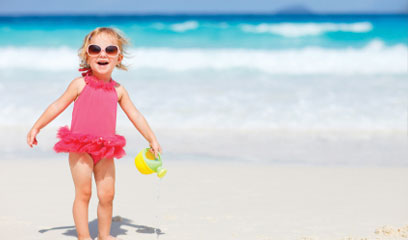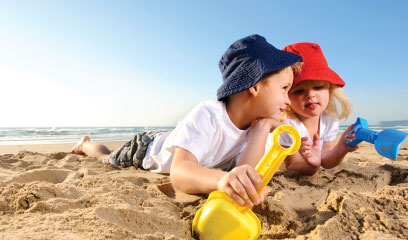Updated July 17, 2012
 Warmer days are upon us. But before your family takes the plunge, take a minute to learn what you can do to keep them safe in the water.
Warmer days are upon us. But before your family takes the plunge, take a minute to learn what you can do to keep them safe in the water.
Drowning is the number-two cause of death for kids younger than 14 in our state, second only to automobile accidents, according to the Washington State Department of Health. “The typical scenario we see is a young child who wanders off and ends up in the water when somebody thinks someone else is watching him,” says Ted Walkley, a pediatric emergency physician at Tacoma’s Mary Bridge Children’s Hospital. “These tragic situations are the most common and the most preventable.”
Constant adult supervision
When you’re in or around water, the simplest and most effective thing you can do is actively supervise your child at all times. “Supervision is the easiest way to prevent drowning,” says Laura Miccile, who is supervisor of the Center for Childhood Safety at Mary Bridge Children’s Hospital.
Mike Koenig, the City of Bellevue’s aquatics manager, recommends identifying one person who’ll stay close to the child. “The supervisor needs to be within an arm’s reach of the child and actively watching — not talking on a phone or visiting with friends.”
Fall City mom Karen Dennis is extremely vigilant about water safety. Dennis, along with her husband and two sons, lives on picturesque Lake Alice and spends warmer days swimming, boating and hosting get-togethers. “I make sure that our boys and guests are clear about our rules,” says Dennis. “My biggest concern is a child falling off the dock and drowning.”
Dennis always makes sure that there is adult supervision. “When we have people over, we designate someone to watch the kids,” Dennis says. She also finds that all children — toddlers through teenagers — need supervision. “The younger kids are easier than the older kids. The teenagers are good swimmers, but they get silly and goofy, and don’t always make good decisions.”
Know your environment
When you’re heading out for a day at the beach, know where you’re going and what you’ll find when you get there.
“Here in Washington, we have lots of open-water drowning deaths,” says Miccile. “People don’t know the water well. They don’t know how it moves, how deep it is and its temperature.”
Most of the area’s streams, lakes and rivers are glacier fed. “The first nice day we get, everyone goes swimming, not realizing that the water is still very cold,” says Miccile. “Parents need to be really careful about getting into the water in the early spring.”
Cold water poses a particular risk to swimmers. “People underestimate the effect of the cold,” says Walkley. “Hypothermia sets in, and the body’s core temperature goes down, and the muscles no longer work. Even if you’re a strong swimmer, you can’t keep yourself up.”
Using proper safety precautions
Having the proper life-saving equipment is one more way to ensure a safe water outing. If young children or weak swimmers are playing near the water, they should be wearing a life jacket. “The jacket needs to be U.S. Coast Guard approved and the right size for your child’s weight,” says Miccile. “A wrong weight could affect the jacket’s buoyancy.”
A proper fit directly correlates to the effectiveness of the jacket. “When you put on the jacket, it should be snug enough that when you pull on the shoulders, they don’t go above the middle of your child’s ears,” says Miccile. Confirm that it’s a good fit whether sitting or standing. “If it’s uncomfortable, the likelihood of them wanting to wear it isn’t great,” she continues. “Life jackets should not be optional while boating. Even parents should always wear a life jacket. If your child sees you wearing one, they’ll know that’s just what you do.”
Consider becoming certified in cardiopulmonary resuscitation (CPR); instruction in CPR can take just a half a day and could one day save a life. “In less than five minutes of being submerged, a child’s heart stops and the potential for brain damage begins,” says Walkley. “Starting CPR right away dramatically increases the chance of survival.” Have a phone ready so you can quickly contact emergency personnel.
Have a phone ready so you can quickly contact emergency personnel.
Child water safety education
You can begin talking with your child about water safety even at a young age. “Parents can help children understand their limitations in the water, so they can avoid dangerous situations altogether,” says Koenig.
When your child is old enough (the American Academy of Pediatrics recommends age 4 or older), teaching her to swim can help keep her safer near water. But Miccile notes that having swimming lessons does not necessarily mean that your child is a strong swimmer. “Don’t depend on the lessons to save your child from drowning,” she says.
It’s hard to beat water play on a sunny day — as long as you’re aware and prepared. “Most horrible tragedies are unfortunate accidents,” says Walkley. “Taking time to stop and think can make a difference.”
More resources on water and water safety
King County resources on water play and safety
13 weeks of summer - 13 weeks to stay safe
Water safety guide from the American Red Cross
Boating: Know the law
Washington has several boating laws, but there are two in particular that all parents should know about:
• All boats (including kayaks and canoes) must have at least one U.S. Coast Guard-approved life jacket per person.
• All children 12 and younger must wear a life jacket at all times when under way in a boat less than 19 feet in length, unless in a fully enclosed area.
Abbey McGee is an Everett-based freelance writer and mother of preschoolers.









